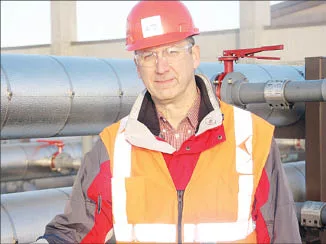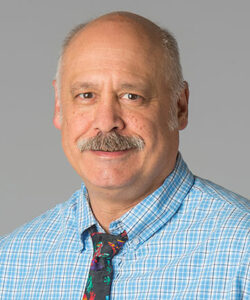
Home » Treatment plant aims to conserve—inside and out
Treatment plant aims to conserve—inside and out
Facility designed to protect aquifer, boasts energy-saving features

January 31, 2013
The whole concept behind a sewer plant, such as the Spokane County Regional Water Reclamation Facility, could be considered green, says David Moss, the county's water reclamation manager, adding that the facility also boasts many green-engineered internal features.
The $144 million facility, which opened just over a year ago, was built to protect the Spokane Valley-Rathdrum Prairie Aquifer from septic-tank pollutants, Moss says. The aquifer is the main source of drinking water for some 500,000 people in Spokane and Kootenai counties.
"The main idea here is to put people on the sewer system so they don't pollute drinking water," Moss says, adding that it's much cheaper to protect drinking water than it is to clean it up.
In addition to its overall mission, the plant, located at the former stockyards site at 1004 N. Freya, features measures that reduce energy consumption and save on operating costs, Moss says. Among the facility's early accolades, the Washington State University Energy Program recognized the plant last month with a Washington Industrial Energy Leaders award for innovation, he says.
The energy-efficiency measures include a cogeneration system that uses methane gas produced in the plant's anaerobic digesters to generate electricity and heat used onsite.
"About 20 percent of the energy we use is produced on our own," Moss says.
Other energy-saving measures include a heat-recovery system in the initial treatment stage that keeps equipment defrosted, and high-efficiency blowers, fans, and motors throughout the sewage treatment process at the plant.
According to Avista Corp.'s estimates, such features that cost a total of $1.5 million will result in annual energy cost savings of $194,800.
In addition to the estimated savings, the measures are eligible for up to $553,400 in incentives as part of federal requirements for industries and utilities to work together to improve energy efficiency, Moss says.
The big picture
Because the plant discharges treated wastewater into the Spokane River, the state requires the facility to remove more than 99 percent of the phosphorus from sewage coming into it, he says.
"We're directed to meet incredibly high levels of treatment that will result in some of the lowest—if not the lowest—pollutant levels in the U.S., particularly for phosphorus," Moss says.
The new plant has remained within its discharge permit requirements every day since it opened, he says.
"It's not easy," Moss says. "That's why the county put out requests for qualifications that amounted to a world competition for talent."
Englewood, Colo.-based CH2M Hill, which has a Spokane office, won the contract in 2009 to design and build the plant and operate it for 20 years.
Spokane-area subcontractors that worked on the project include Coffman Engineers Inc., ZBA Architecture PS, Garco Construction Inc., Halme Construction Inc., and Power City Electric Inc.
Moss says some minor construction still is under way to help optimize the treatment process.
"We're using the leading edge of proven technologies," he says. "It can take up to two years through various seasons to dial it all in."
CH2M Hill employs a 12-person staff to operate the facility, and the county employs another six people at the plant, including its wastewater resources staff.
The plant is treating an average of 6.7 million gallons of sewage a day, serving a population of roughly 100,000 people.
Under its current capacity of 8 million gallons a day, the plant has more than enough capacity to handle sewage from 5,000 additional households in the Valley that still are connected to septic systems, he says.
The plant, which currently takes up less than a third of its 20-acre site, also is designed to expand to treat up to 24 million gallons a day.
"It's all set up to expand in modular quantities," Moss says. "It can expand by another 4 million gallons quite quickly. I think 24 million gallons is the maximum size it would ever need to be even for the projected 50-year growth for our service area."
The plant costs the county $6 million a year to operate, Moss says. Of that, $600,000 goes into a major-equipment repair and replacement fund.
The monthly sewer services fee for a single-family residence in unincorporated Spokane County is $45.16, and the fee for single-family residences in Spokane Valley is $46.26.
By comparison, the city of Spokane's monthly sewer services fee is $55.15 for single-family residences inside the city, and $81.51 for its residential accounts outside of the city, to treat sewage at its separately operated plant at 4401 N. Aubrey L. White Parkway in northwest Spokane.
Under an agreement with the city, the county can send up to 10 million gallons of sewage a day to the city's treatment plant, but currently is sending only about 1.8 million gallons a day there, mostly from the northern part of the county, Moss says.
"The flow we take in relaxes the pressure on the city. It allows the city to expand more easily, when they won't have to deal with as much flow," he says, adding that the city of Spokane also plans to expand and improve its sewage treatment plant. That plant, the Riverfront Park Water Reclamation Facility, also discharges treated wastewater into the Spokane River.
Treatment process
At the Spokane County Regional Water Reclamation Facility, sewage goes through many stages of treatment. The facility produces reclaimed water that can be discharged into the river—or used other ways—and biosolids that are hauled off-site to be made into compost.
As sewage arrives at the plant through two main sewer lines, it's first treated at the initial containment area called the head works, which screens out rags, plastics, and other large inorganic objects, and sends the sewage through a sand- and grit-removal process.
Sewage then goes through two primary-clarifier tanks that settle out some of the solids and grease.
In the next step, beneficial microbes separate suspended solids from the effluent.
"Sometimes we add oxygen depending on the metabolism of the biological agents," Moss says.
The county kick-started its biological treatment by hauling in 200,000 gallons of microbe-laden sludge from the city's treatment plant.
"The city had healthy and robust activated sludge," Moss says.
The effluent then goes through a membrane system that includes 6 million hollow fibers that look like long, taut strands of spaghetti. The water percolates through microscopic pores that filter out tiny particles.
The fibers, which regularly are back flushed, cleaned, and rejuvenated, can last up to 10 years, Moss says.
In the final two treatment stages, the water is disinfected with chlorine and then dechlorinated to meet water quality standards for discharge into the river.
The treated wastewater also can be reclaimed for a number of other uses, Moss says.
"You could swim and fish in it and irrigate with it with very few restrictions," he says. "The only thing we can't do is pipe it to drinking water systems."
Meantime, solids separated at the primary settling and biological aeration stages are blended, dewatered, and biologically processed in the plant's two anaerobic digesters, which are two of the tallest structures at the facility.
Biosolids then are treated through another biological process during an aeration stage, further dewatered, and finally transported to the Barr-Tech LLC facility in rural Lincoln County west of Spokane.
The biosolids then are used as a main component in manufacturing high-grade compost.
Typically, it takes five to 10 hours for liquids to go through the treatment process, and it takes 20 to 30 days to process solids, Moss says.
Most of the sewage treatment process is covered to keep odors from escaping the plant.
High-capacity air blowers send foul air through a separate biological treatment in which air is filtered through beds of woodchips containing odor-eating microbes.
The final exhaust then carries a non-offensive, light earthy, almost flowery odor.
From the outside of the facility, the Spokane Regional Water Reclamation plant even smells kind of green, Moss says.
Up Close
Related Articles



_web.webp?t=1764835652)
